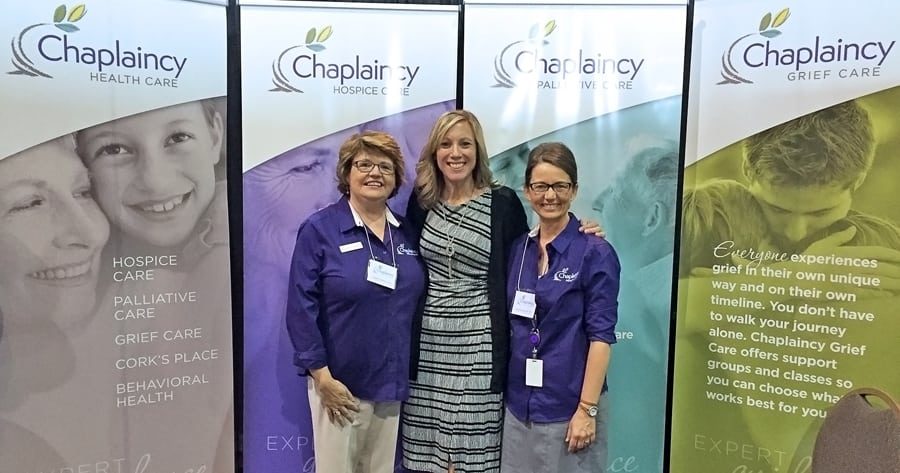
Home » New name, image helps Chaplaincy Health Care better connect with community
New name, image helps Chaplaincy Health Care better connect with community

July 15, 2016
The organization once known as Tri-Cities Chaplaincy has been given a new name and image that better reflects the evolution and expansion of its care.
The rebranding project has been two years in the making, said Leslie Streeter, director of communications of the non-profit organization now called Chaplaincy Health Care.
“We started really wondering if the name ‘Chaplaincy’ was a fit for what we do now. We were getting the sense that it was causing a lot of confusion. People were trying to figure out what ‘The Chaplaincy’ really meant, so we ended up working with a consulting firm out of Ohio,” Streeter said.
The firm, Transcend Hospice Marketing, recommended doing a community survey. About 300 people were interviewed in Benton and Franklin counties, and while the results showed people knew about hospice in general, Streeter said they were surprised to hear how residents perceived the name ‘Chaplaincy.’
“What we learned was that the community has some basic understanding of hospice but definite gaps. They didn’t know there was more than one hospice in the community, and when we asked who provides hospice care, 70 percent said they didn’t know,” Streeter said. “The real issue was the connection.”
Chaplaincy Health Care has been around since 1971 when several churches got together to utilize some seminary graduates to provide outreach to people who couldn’t make it to church.
“It started with just one chaplain as a pilot project,” Streeter said. “They ended up getting a grant to continue the work, then in 1974, they got some United Way funding and it just continued growing.”
In the 1980s, as hospice services grew around the country, the agency was asked to spearhead the effort to provide end-of-life care.
Since then, Chaplaincy Health Care has also grown to include palliative care—a pre-hospice program for folks who are struggling with serious chronic illnesses and might still be receiving treatment—as well as grief care.
“Hospice is a benefit through Medicare and Medicaid, and part of those benefits is that the family receives 13 months of grief support,” Streeter said. “We offer a couple of different groups and some classes, too. And those aren’t just for hospice families, those are open to the general public as well.”
The results from the community study confirmed that there was no need to remove the word ‘chaplaincy’ from the agency’s name. Rather, the agency needed a name that represented the full spectrum of services it provided.
“And keeping the word ‘chaplaincy’ helps us embrace our heritage and keep us grounded in the spirit of which we were formed,” Streeter said. “Adding ‘health care’ was just a good way to help specify the categories of services we provide. Plus, it gives us nice flexibility to accommodate future growth, so as we add other programs and services that are health-related or end-of-life, they’ll fit very nicely under that umbrella.”
On June 7, the logo and name change was rolled out to staff. Streeter said there was a jar set up in the staff kitchen where employees could guess the new name. After the staff reveal, Chaplaincy Health Care announced the news to the general public at the 8th annual Senior Life Show in Kennewick, and will continue to spread the word through brochures, business cards and advertising.
“Blue has been our color since the very beginning,” Streeter said about the former logo. “Now our color palette has four or five colors in it, but purple is our primary color. It’s just refreshed things a little and brought us up a notch in so far as everything looking cohesive and professional.”
The new icon includes a tree, and Streeter said the marketing firm came up with the idea from a Native American practice of bending young saplings to mark trails as they were hunting or exploring.
“They took the concept and used it for the logo. It has three leaves that represent mind, body and spirit. That tree wraps around the word ‘chaplaincy’ that is in purple,” Streeter said. “It’s very different because the original logo had a dove and it was all blue.”
In 2015, the hospice arm of the agency worked with 850 patients. Its palliative care program reached more than 250 people, and 1,450 people received bereavement counseling and care. As the brand campaign raises awareness in the community, Chaplaincy Health Care expects those numbers to grow.
“We’re looking at additional ways to serve our community. One through our palliative care is called mobile medicine. What we’re hoping to do is be able to provide primary care through a facility,” she said. “Oftentimes residents in assisted living facilities—they have a hard time getting to their physician. We’d like to set up some office hours inside a facility so residents can get a basic once-over and adjust medication. So they don’t have to leave the facility.”
For more information about the agency and its services, visit chaplaincyhealthcare.org.
Local News Charitable Giving & Nonprofits Nonprofits
KEYWORDS july 2016





